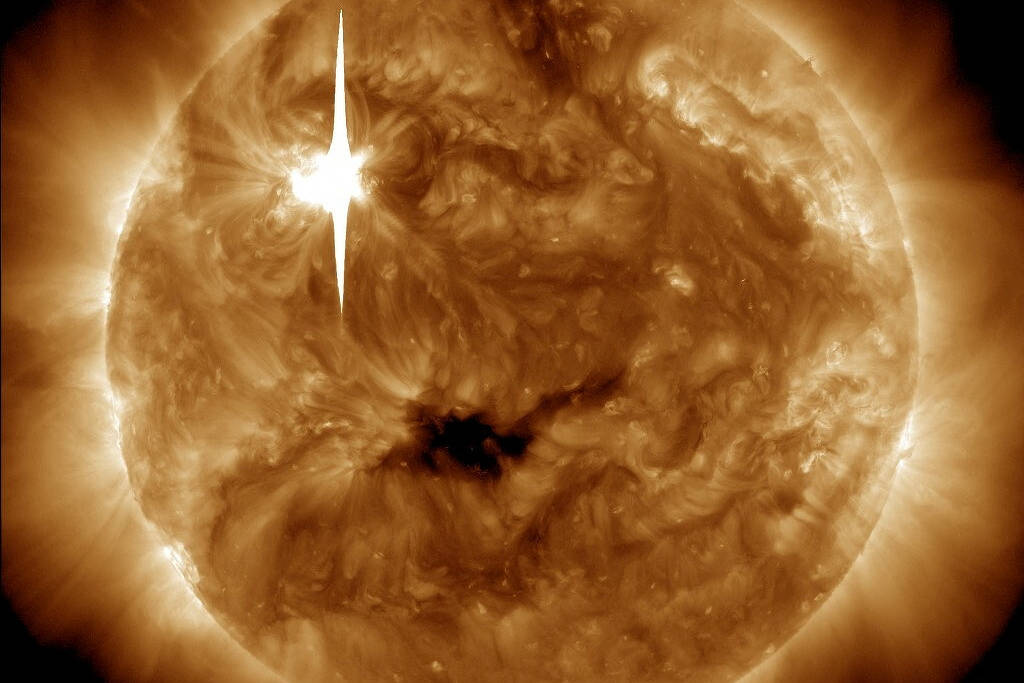Solar flares are extremely intense events that occur in the Sun's atmosphere for periods ranging from minutes to a few hours. According to the Standard Model, the energy that causes such phenomena is transferred by accelerated electrons that rush from the magnetic reconnection region in the corona into the heliosphere. Through collisions, these electrons deposit energy in the chromosphere, causing heating and ionization of the plasma and intense radiation in various bands of the electromagnetic spectrum. The regions of energy deposited are called the “feet” of the flare arcs and typically appear in magnetically coupled pairs.
To test the validity of the Standard Model, a recent study compared the results of model-based computer simulations with observational data from the McMath-Pierce telescope during the SOL2014-09-24T17:50 eruption. The focus of the study was to measure the time lag in infrared (IR) emission from two paired chromospheric sources. a job It was published in the Monthly Notices of the Royal Astronomical Society.
“We found an important difference between the data provided by telescopic observations and the behavior predicted by the model. In telescopic observations, the double arc feet appear as two bright regions in the solar chromosphere. Since the electrons coming from the same region of the corona are traveling along similar paths, the two spots would be expected, based on the model, to shine almost simultaneously in the chromosphere, but that is not what the telescopic observations showed,” says Paulo José de Aguiar Simões, a professor at the University of California, Mackenzie Presbyterian School of Engineering, a researcher at the Mackenzie Center for Radio Astronomy and Astrophysics, and the first author of the paper.
A delay of 0.75 seconds may seem insignificant, but looking at all possible geometric configurations, the researchers found that based on the model, the maximum delay would be 0.42 seconds. The real number is much higher.
“We used a sophisticated statistical technique to infer the time differences of the arc foot emissions, and the so-called Monte Carlo method to estimate the uncertainties in these values. Furthermore, the results were tested with electron transport and radiodynamics simulations. With all these resources, we were able to build different scenarios for the time of the electrons’ journey from the corona to the atmosphere and the time of infrared radiation production, and all the scenarios based on the simulations showed much smaller time differences than those obtained by telescopic observations,” Simões tells.
One scenario tested was spiraling and magnetic trapping of electrons in the corona. “Using electron transport simulations, we explored scenarios of magnetic asymmetry between the arc feet. The expectation was that the greater the difference in magnetic field strength between the arc feet, the greater the time delay in electron penetration into the chromosphere. This should also cause a greater variation in the amount of electrons reaching the chromosphere, due to the magnetic trapping effect. However, analysis of the X-ray observation data showed very similar intensities arising at the foot of the arcs, suggesting similar amounts of electron deposition in these regions, so the reason for the observed delay in emission was not present.”
The radiative hydrodynamic simulations also showed that the ionization and recombination times in the chromosphere are too fast to explain the delay. “We simulate the generation time of the infrared emission. In addition to calculating the transfer of electrons to the chromosphere, we also calculate their energy deposition and the consequences they produce in the plasma: heating, expansion, ionization and recombination of hydrogen and helium atoms; locally produced radiation, which has the effect of releasing excess energy. The infrared radiation is produced as a result of the increase in electron density in the chromosphere, as a result of the ionization of hydrogen, which was originally in a neutral state in the plasma. We showed that with the penetration of accelerated electrons, ionization and generation of infrared emission are almost instantaneous, and therefore unable to explain the 0.75-second delay between arc-foot emissions,” explains Simões.
In short, none of the processes simulated by the model were able to explain the observed data. For this reason, the researchers’ conclusion was fairly straightforward: the standard model needed to be reformulated. That’s how science works. “The observed time delay between chromospheric sources challenges the standard model of energy transport by electron beams. The presence of a longer delay suggests that other energy transport mechanisms may be at play. Mechanisms such as magnetic waves, conductive transport, or other forms of energy transport may be needed to explain the observed delay, and these additional mechanisms must be considered to fully understand solar flares.”

“Wannabe internet buff. Future teen idol. Hardcore zombie guru. Gamer. Avid creator. Entrepreneur. Bacon ninja.”

